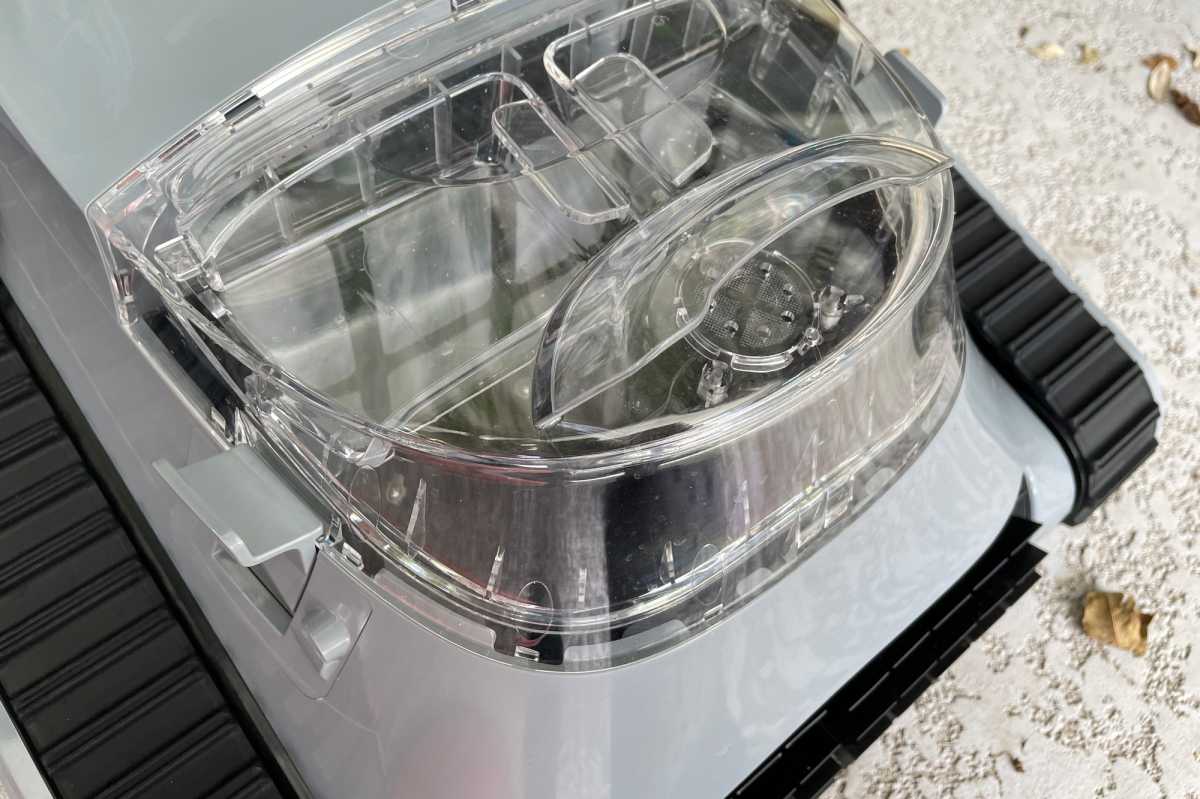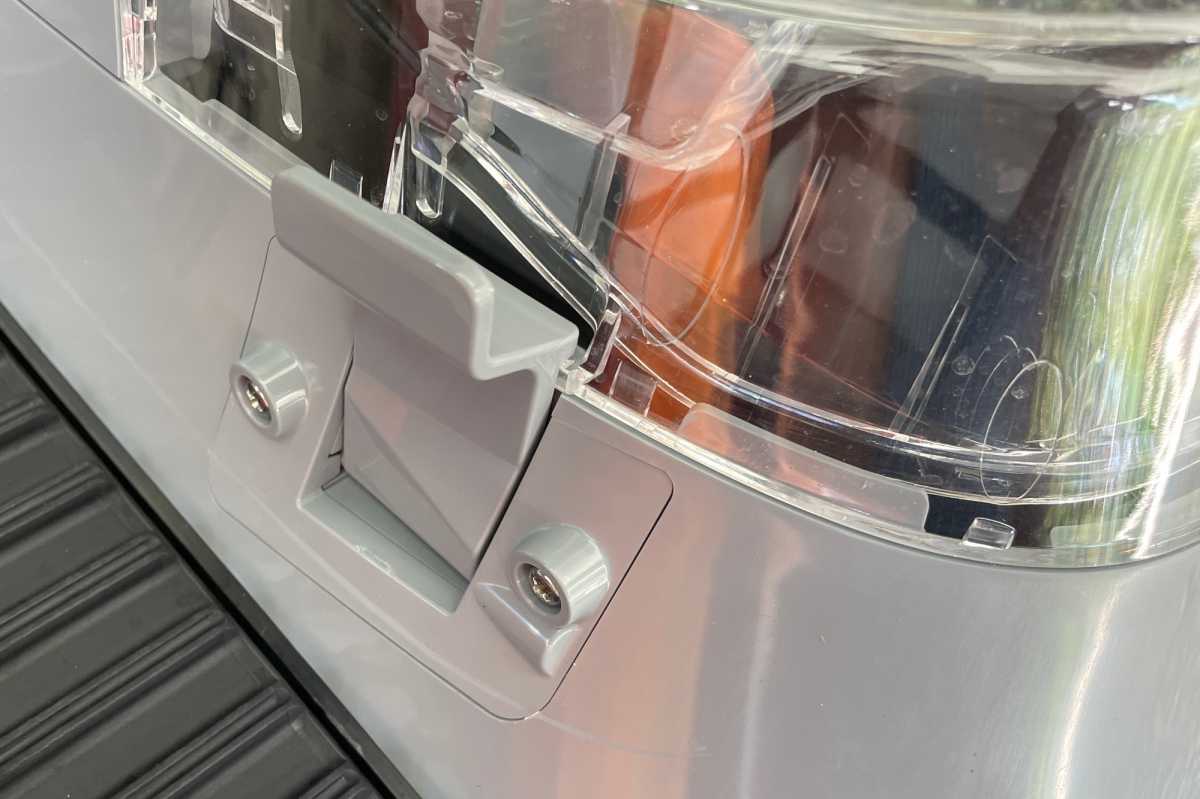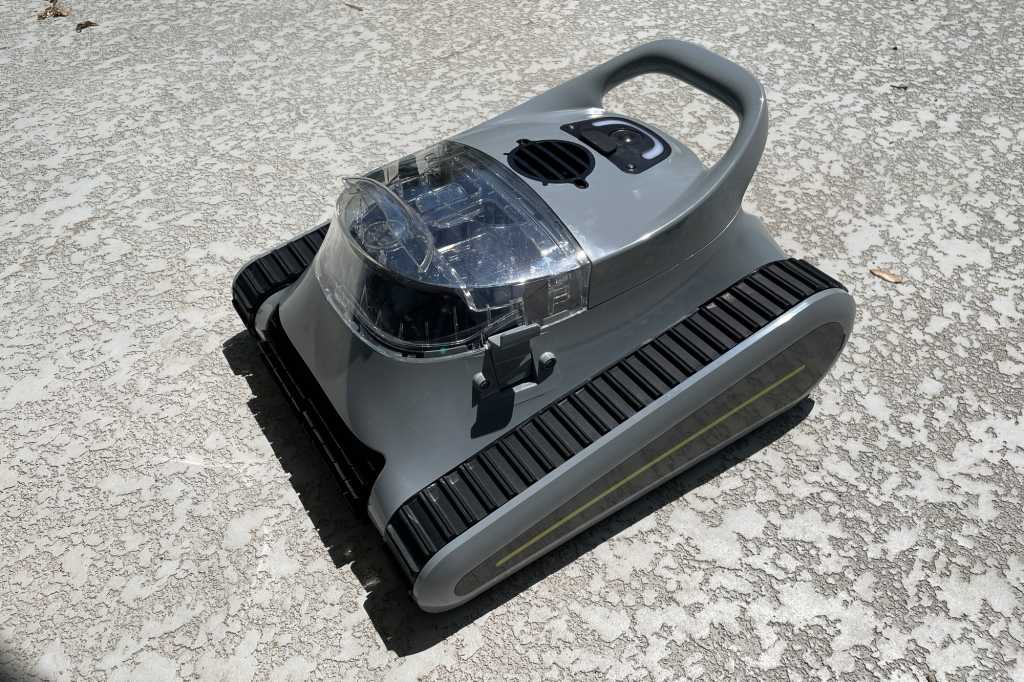Expert’s Rating
Pros
- Compact, attractive design
- Reasonably inexpensive
Cons
- Awful coverage levels
- Dirt from its filter drained back into the pool
- Poor pathfinding
- Difficult-to-reassemble filter
Our Verdict
This robotic pool cleaner is difficult to use and does an awful job cleaning up debris. Skip it.
Price When Reviewed
$399.00
Best Prices Today: Seauto Crab
$399.99
Seauto’s first pool robot was a distinctive and largely capable underwater scrubber, thanks in part to its unique high-filtration system and aggressive approach to scrubbing the waterline tile. The newer, more compact, and much cheaper Seauto Crab lacks everything that made the Shark compelling.
A new design gives the Crab—gray with black treads and yellow trim—a more streamlined and less bizarre appearance. While it still weighs nearly 20 pounds, it’s easy to move around and get in and out of the pool. The robot charges with a standard power brick that physically connects to a port on the robot that’s sealed with a rubber plug when not in use. A single power button up top turns the unit on and off and lets you cycle through three operating modes: floor only, walls only, or both, which Seauto calls “all-cover mode.”
This review is part of TechHive’s in-depth coverage of the best robotic pool cleaners.
A friendly voice announces each of these modes aloud as you cycle through them, as well as utterances of other notices, such as a low battery condition, although the constant repetition of the lattermost can quickly become tedious. The bot doesn’t come with a mobile app, so you can’t control it with your phone.

The Seauto Crab’s three-part filter cover is very difficult to get properly seated.
Christopher Null/Foundry
Using the Seauto Crab
Getting the Crab going requires little effort. Just power it on, drop it into the water, and it scoots along, fairly speedily but also haphazardly, with 1,614 square feet of coverage promised. Two large treads with a central scrubbing cylinder help it maneuver. Running time is specified at 1.5 hours from its 7800mAh battery. My test unit regularly managed close to 2.5 hours on a full charge. Since the Crab does not surface itself after a run, it must be retrieved manually with a pole and the included hook attachment.
The Crab immediately struggled in my L-shaped pool, spending an inordinate amount of time in the shallow end before finally moving to deeper waters. In subsequent tests, I even tried manually moving the robot from the shallow end into the deep end, but regularly I would find it returning to the shallow water which it had already traversed multiple times.
The Crab also has a strange approach to cleaning walls. While the Shark would climb the wall, then grind laterally across the waterline, scrubbing the tile as it moved, the Crab climbs the wall vertically, scrubs the tile in that spot for a bit, and then simply stops and falls back to the bottom of the pool, a foot or so away from the wall. While many pool cleaners will reverse and move back down the wall, scrubbing again as they make their way back to the floor, the Crab just drifts down to the bottom as if it had been dropped into the water. It’s weird to watch—and surely a missed opportunity to clean twice as hard.

These clips, on either side of the filter cover, are both awkward and difficult to snap into place.
Christopher Null/Foundry
Making matters worse, the Crab just didn’t do a great job. After a big windstorm, I found my pool full of leaves and dirt: a perfect opportunity for testing. The Crab wanted nothing to do with it, though. After a full run, I achieved maybe 20 percent coverage, the bottom of the pool still caked with debris—dirt especially. When I removed the Crab from the pool to clean it, I watched a significant amount of the dirt that it did manage to capture drain from the base of the robot, back into the pool from where it had come. This is probably a failure of the filter basket design, but it’s a massive disappointment considering the dirt-grabbing capabilities of the older Shark.
Even cleaning the Crab is difficult thanks to a complicated filter basket and cover that is tough to remove. The multi-step process requires unclipping two very stiff levers that snap into place on top of a clear plastic cover that is itself awkward to position properly on top of the robot. Rinsing out the basket itself isn’t particularly hard, but reassembling everything later is more complex and frustrating than any robot I’ve tested to date.
Later runs with artificial leaves were more successful than my organic debris tests, providing about 75 percent coverage. That may sound like a big improvement over the 20 percent mark for organic debris, but a robot that can’t sweep up at least 90 percent of your pool’s grime is inevitably a big disappointment that will leave your pool looking decidedly dirty.
Should you buy the Seauto Crab?
At $399, the Seauto Crab is less than half the price of the Shark; but as I suggested earlier, you’re getting far less than half the robotic cleaner for that outlay. The lack of wireless features and the awkward filter cover would be forgivable if the unit did a great job of cleaning the pool, but the Crab doesn’t even get that right.



